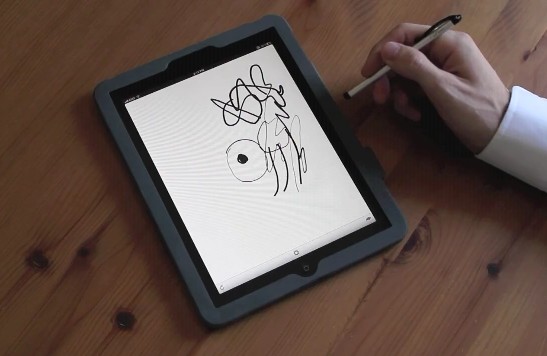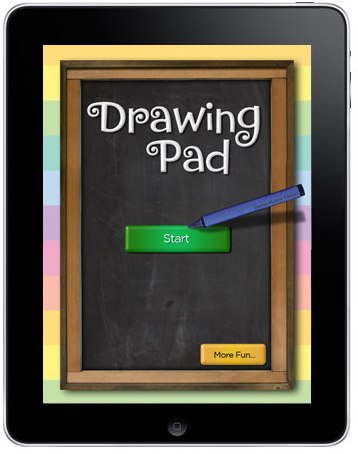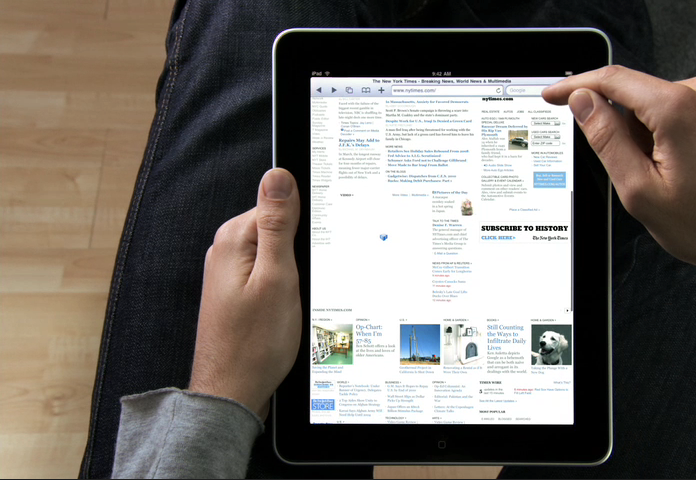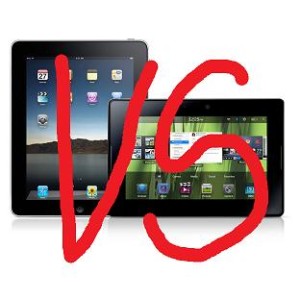Thanks to the smart people at Ten One Design this could soon change. The company has managed to build a private function call that allows a special pen to be used with varying degrees of pressure. When pressing down harder the line you draw gets darker and when pressing lightly the line is more faded….
“The iPad’s IPS panel is pressure-sensitive, you say?” No, that’s not quite right, but with some clever software and a special capacitive stylus, the folks at Ten One Design built a convincing proof of concept anyhow. While we’re not quite sure how it works, the current theory states that the soft tip of the stylus expands like a brush when you press it down, generating a “larger press” that can be detected by the hooks in Ten One’s code — which they soon plan to share as a free software library (assuming Apple allows) with developers around the world. See it in action in a video after the break, and if you’re feeling your inner Rorschach today, let us know what you see in the above drawing.
Ten One Design has developed some interesting software to simulate a pressure-sensitive screen on the iPad. The app works by measuring distance between the touch screen and a capacitive tip such as that found on the Pogo Sketch stylus.
When they’re not rolling sheets of metal into tubes and stuffing them with conductive foam to make iPhone styluses, the smart engineers at Ten One design are hacking away at the iPad. And quite miraculously, they have managed to turn the iPad’s screen into a pressure sensitive drawing tablet.
Right now the software collects screen input data using a private function call, so Apple would not allow the program into the AppStore under current rules. Ten One Design hopes to release this capability as a free software library with permission from Apple.
Proper graphics tablets like those from Wacom have pens which detect thousands of levels of pressure, but the iPad offers just two levels: one and zero. To get around this, the Ten One people, makers of the Pogo stylus, have hacked Apple’s private UIKit frameworks to enable the screen to detect pressure.
The UIKit framework could be updated to include the necessary information, making it possible for any iPad developers to make simulated pressure-sensitive apps. Ten One Design warns that lag seen in the demo video is an issue with the demo app code, not a limitation of the iPad or the pressure-sensitive library.
Another benefit of this application and the use of this pen is that while writing or drawing on the pad, if the writer somehow puts the pressure of his palm on the pad then also there will be no mark on the pad. That ensures easy handling and trouble free use of the stylus on the pad. Those who have doubts on the functioning of the special pen can have a look at the video release of the pen in action on the pad. Well, at this moment only it can be expected that the Apple people have a look at this video and decide to approve this great work of Ten One.
Unfortunately, Ten One doesn’t have software to sell yet; the tech above uses a private API call, which means it couldn’t be approved on the App Store. As far as I can guess, they’re somehow passing pressure information back through the stylus to the iPad, since the iPad’s screen itself isn’t pressure sensitive at all.
If Apple lets this third-party innovation see the light of day, iPads could prove even more functional with the right apps and a decent stylus in hand. Handwriting recognition software already exists, and in combination with the iPad touch screen we can imagine many new uses for the device.
According to the developer, the delay seen on-screen is due to a software issue they had at the time of filming… it isn’t a limitation of the iPad or the application and is more real-time from what they say.
As a few of our observant commenters noted, there’s no Bluetooth call here — the private API call is just tracking the size of the touch on the iPad’s screen — bigger touch means more pressure and a wider stroke. That does seem like something Apple could eventually implement, so hopefully they will make that official in the future.
Resources :engadget.com,theipadguide.com,wired.com,tuaw.com







Pingback: HOTTEST ELECTRONICS AVAILABLE!!!
This information is almost a year old.
This information is almost a year old.